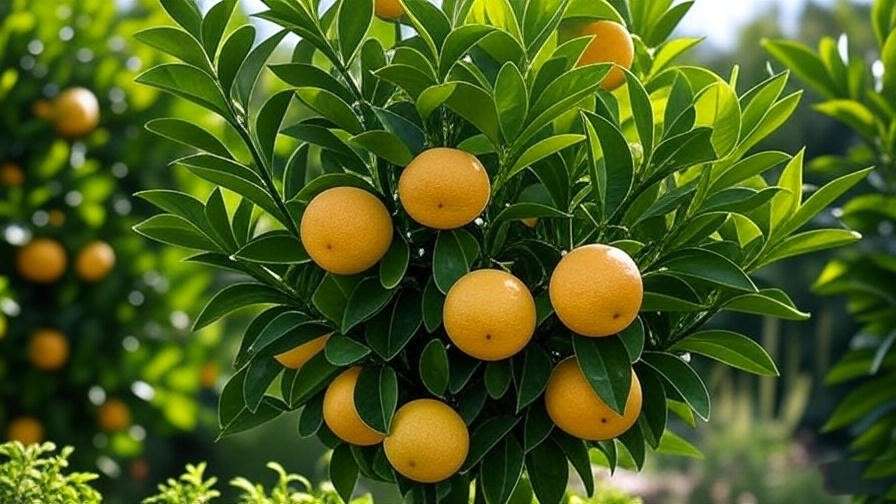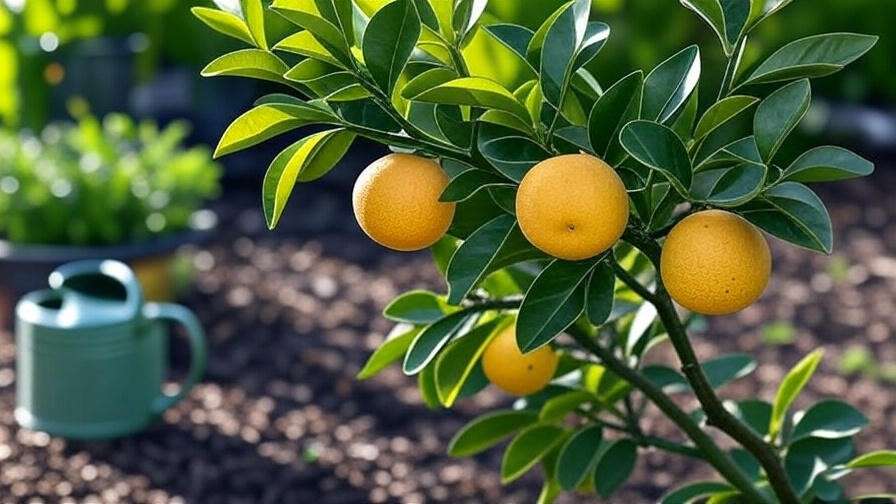Picture this: stepping into your backyard to pluck a juicy, sun-ripened grapefruit from your very own grapefruit tree, bursting with flavor and packed with nutrients. 🌞 Growing a grapefruit tree is not only a rewarding gardening adventure but also a way to bring vibrant beauty and delicious fruit to your home. Whether you’re a seasoned gardener or a beginner, this comprehensive guide will equip you with expert tips to cultivate a thriving grapefruit tree. From planting to harvesting, we’ll cover every step to ensure abundant harvests. Backed by years of horticultural expertise, this article addresses common challenges and delivers actionable advice to make your citrus dreams a reality.
1. Why Grow a Grapefruit Tree? 🌟
Grapefruit trees are a fantastic addition to any garden, offering a blend of practical benefits and aesthetic charm. Let’s explore why cultivating one is worth your time and effort.

1.1 Benefits of Grapefruit Trees
Grapefruits are nutritional powerhouses, rich in vitamin C, vitamin A, antioxidants, and dietary fiber. A single fruit can provide over 70% of your daily vitamin C needs, boosting immunity and promoting healthy skin. Beyond health benefits, grapefruit trees add ornamental value with their glossy green leaves and fragrant white blossoms, transforming your garden into a tropical oasis. Plus, growing your own fruit saves money on grocery bills and ensures pesticide-free produce. Imagine the satisfaction of sharing homegrown grapefruits with friends and family! 😊
1.2 Understanding Grapefruit Tree Varieties
Choosing the right variety is key to success. Popular grapefruit varieties include:
- Ruby Red: Known for its sweet-tart flavor and deep pink flesh, ideal for warm climates.
- Star Ruby: Seedless with vibrant red flesh, perfect for juicing.
- White Marsh: Tangy and juicy, great for cooler regions within citrus-growing zones.
Each variety has unique traits, such as fruit size, flavor profile, and climate adaptability. For best results, select a variety suited to your USDA hardiness zone (typically 9–11). Expert Tip: Consult your local nursery or extension service to match varieties to your region’s climate.
2. Getting Started: Choosing the Right Grapefruit Tree 🌱
Before you plant, selecting a healthy tree and understanding its needs sets the foundation for success.
2.1 Selecting a Healthy Tree
Purchase your grapefruit tree from reputable sources like local nurseries, garden centers, or trusted online suppliers. Look for trees with:
- Strong, straight stems.
- Vibrant, green leaves without yellowing or spots.
- No signs of pests or diseases, such as webbing or sticky residue.
Opt for grafted trees over seed-grown ones, as they produce fruit faster (within 2–3 years) and are more resilient. Expert Insight: Check the graft union (where the rootstock meets the scion) for a clean, healthy connection.
2.2 Ideal Growing Conditions
Grapefruit trees thrive in warm, sunny climates with specific environmental needs:
- Climate: Best in USDA zones 9–11, where temperatures rarely dip below 20°F (-6°C).
- Soil: Prefers well-draining, loamy soil with a pH of 5.5–6.5. Avoid heavy clay or waterlogged soils.
- Sunlight: Requires 6–8 hours of direct sunlight daily for optimal growth and fruiting.
Test your soil’s pH with a home kit or send a sample to a local extension service for analysis. If the pH is too high, amend with sulfur; if too low, add lime. Tip: Ensure good drainage by planting on a slight mound in heavy soil areas.
3. Planting Your Grapefruit Tree 🌍
Proper planting establishes a strong root system, setting your tree up for long-term health.
3.1 When and Where to Plant
The best time to plant a grapefruit tree is in spring or early fall, allowing roots to establish before extreme heat or cold. Choose a sunny, sheltered spot protected from strong winds, which can damage branches or dry out the tree. Avoid low-lying areas prone to frost or flooding.
3.2 Step-by-Step Planting Guide
Follow these steps for a successful planting:
- Dig the Hole: Make it twice as wide and as deep as the root ball (e.g., 2–3 feet wide for a 15-gallon tree).
- Amend Soil: Mix native soil with compost or aged manure to boost nutrients and drainage.
- Position the Tree: Place the tree so the graft union is 2–3 inches above soil level to prevent rot.
- Backfill and Tamp: Fill the hole with soil, gently tamping to remove air pockets.
- Water Thoroughly: Give the tree a deep soak (about 5 gallons) to settle the soil.
- Mulch: Apply a 2–3-inch layer of organic mulch (e.g., wood chips) around the base, keeping it 6 inches from the trunk to avoid rot.
Example: Jane, a Florida gardener, planted a Ruby Red grapefruit tree in spring using this method. By year three, her tree produced 20 pounds of fruit, proving the value of proper planting techniques.

4. Essential Care Tips for a Thriving Grapefruit Tree 🌿
Consistent care is crucial for a healthy, productive tree. Here’s how to nurture your grapefruit tree.
4.1 Watering Needs
Grapefruit trees need regular, deep watering to support root development and fruit production:
- Frequency: Water 1–2 times per week, delivering 5–10 gallons depending on tree size and weather.
- Adjustments: Increase during hot, dry spells; reduce during rainy seasons.
- Signs of Imbalance: Yellowing leaves may indicate overwatering, while wilting suggests under-watering.
Use a soaker hose or drip irrigation for efficient, even moisture. Tip: Check soil moisture 2 inches deep; water only when it feels dry.

4.2 Fertilizing for Growth
Fertilization fuels growth and fruiting:
- Type: Use a balanced citrus-specific fertilizer (e.g., 10-10-10 or 8-8-8) with micronutrients like zinc and magnesium.
- Schedule: Apply every 6–8 weeks from spring to early fall, avoiding winter to prevent new growth during frost.
- Organic Options: Compost tea or fish emulsion provides a sustainable nutrient boost.
Apply fertilizer evenly around the drip line (the area under the canopy’s edge). Expert Insight: Over-fertilizing can burn roots, so follow package instructions and avoid applying near the trunk.
4.3 Pruning and Shaping
Pruning maintains tree health and maximizes fruit production:
- When: Prune in late winter or early spring before new growth begins.
- How: Remove dead or damaged branches, suckers (growth below the graft), and overcrowded limbs to improve air circulation.
- Tools: Use clean, sharp pruning shears to prevent disease spread.
Regular pruning encourages sunlight penetration, reducing pest issues and boosting fruit quality. Tip: Shape young trees to an open-center structure for balanced growth.
5. Protecting Your Grapefruit Tree from Pests and Diseases 🐛
Vigilance is key to keeping your tree healthy and pest-free.
5.1 Common Pests
Grapefruit trees face threats from:
- Citrus Leaf Miners: Cause wavy trails on leaves; control with neem oil sprays.
- Aphids: Suck sap and spread viruses; use insecticidal soap or ladybugs as natural predators.
- Scale Insects: Appear as small, waxy bumps; remove with horticultural oil.
Inspect leaves and stems weekly, especially new growth. Expert Tip: Introduce beneficial insects like lacewings to naturally reduce pest populations.
5.2 Common Diseases
Key diseases include:
- Citrus Greening (Huanglongbing): Causes misshapen, bitter fruit; no cure, so focus on prevention via healthy practices and pest control.
- Root Rot: Results from overwatering; ensure proper drainage and avoid mulch against the trunk.
- Anthracnose: Fungal disease causing leaf spots; treat with copper-based fungicides.
Early detection is critical. Expert Insight: Quarantine new citrus plants for 2–3 weeks to prevent introducing diseases like citrus greening.
6. Maximizing Fruit Production 🍈
A thriving grapefruit tree can yield dozens of fruits each season with the right care. Here’s how to ensure a bountiful harvest.
6.1 Pollination and Flowering
Grapefruit trees are self-pollinating, meaning they don’t require a second tree to produce fruit. However, pollinators like bees can boost fruit set by transferring pollen more efficiently. To encourage flowering:
- Ensure Adequate Sunlight: At least 6–8 hours of direct sun promotes healthy blooms.
- Provide Proper Nutrition: Use a fertilizer high in phosphorus during the flowering season to support bud development.
- Avoid Stress: Consistent watering and pest control prevent flower drop.
If you notice sparse blooms, evaluate light exposure or nutrient levels. Tip: Plant pollinator-friendly flowers like lavender nearby to attract bees and enhance pollination.
6.2 Harvesting Tips
Timing and technique are critical for harvesting flavorful grapefruits:
- When to Harvest: Grapefruits typically ripen 8–12 months after flowering, depending on the variety. Look for firm, vibrant fruits with a slight give when gently squeezed. Ruby Red and Star Ruby varieties often show a rich color when ready.
- How to Harvest: Use pruning shears to cut the fruit from the stem, leaving a small stub to avoid tearing the branch. Twisting or pulling can damage the tree.
- Storage: Store grapefruits in a cool, dry place (around 50°F/10°C) for up to a month. Refrigerate for longer freshness.
Example: A California gardener reported harvesting 50 grapefruits from a 5-year-old White Marsh tree by timing the harvest for early winter, ensuring peak sweetness.
7. Troubleshooting Common Grapefruit Tree Problems 🔍
Even with diligent care, grapefruit trees can face issues. Here’s how to diagnose and fix common problems.
7.1 Leaf Drop or Yellowing
Leaf issues often signal environmental or care-related problems:
- Causes:
- Nutrient Deficiencies: Lack of nitrogen or magnesium causes yellowing (chlorosis).
- Overwatering: Soggy roots lead to leaf drop and yellowing.
- Pests: Aphids or mites can stress the tree, causing leaf loss.
- Solutions:
- Test soil for nutrient levels and apply a citrus-specific fertilizer if needed.
- Adjust watering to ensure soil dries slightly between sessions.
- Inspect for pests and treat with organic sprays like neem oil.
Expert Insight: If leaves yellow at the veins, suspect iron deficiency and apply chelated iron to the soil.
7.2 Poor Fruit Yield
Low fruit production can be frustrating but is often fixable:
- Causes:
- Inadequate Sunlight: Shaded trees produce fewer flowers and fruits.
- Improper Pruning: Over-pruning can remove fruiting wood.
- Young Tree Age: Trees under 3–5 years may not yet bear heavily.
- Fixes:
- Relocate potted trees to sunnier spots or trim nearby shade sources.
- Prune strategically to maintain fruiting branches, focusing on deadwood removal.
- Be patient with young trees, as they prioritize root and canopy growth initially.
Tip: Apply a bloom-boosting fertilizer (high in phosphorus) in early spring to encourage fruit set.
8. Growing Grapefruit Trees in Containers 🪴
Container gardening is a game-changer for small spaces or colder climates, allowing anyone to grow a grapefruit tree.
8.1 Benefits of Container Growing
Growing grapefruit trees in pots offers:
- Flexibility: Move the tree to optimize sunlight or protect it from frost.
- Space Efficiency: Ideal for patios, balconies, or small yards.
- Climate Control: Bring indoors during cold snaps in zones below 9.
Container trees can produce just as much fruit as in-ground ones with proper care. Example: A Seattle gardener successfully grew a Star Ruby grapefruit tree in a container, moving it indoors during winter and harvesting 10–15 fruits annually.

8.2 Container Care Tips
To thrive in a pot, grapefruit trees need:
- Pot Size: Start with a 15-gallon container with drainage holes; upgrade to 20–25 gallons as the tree grows.
- Soil Mix: Use a blend of 60% potting soil, 20% perlite, and 20% compost for drainage and nutrients.
- Watering: Water when the top 2 inches of soil feel dry, ensuring excess water drains freely.
- Winter Care: Move to a sunny indoor spot (near a south-facing window) or use frost blankets in mild climates.
Expert Tip: Rotate the pot every few weeks to ensure even sunlight exposure for balanced growth.
9. Seasonal Care Calendar for Grapefruit Trees 📅
A year-round care schedule keeps your tree healthy and productive:
- Spring:
- Fertilize every 6–8 weeks with a citrus-specific formula.
- Prune to shape the tree and remove winter damage.
- Monitor for pests like aphids as new growth emerges.
- Summer:
- Water deeply and consistently, especially during heatwaves.
- Apply mulch to retain moisture and regulate soil temperature.
- Watch for leaf miners and treat promptly.
- Fall:
- Reduce fertilization as growth slows.
- Harvest ripe fruit and inspect for disease.
- Prepare for cooler weather by checking drainage.
- Winter:
- Limit watering to prevent root rot in cooler, wet conditions.
- Protect from frost with blankets or by moving potted trees indoors.
- Avoid fertilizing to prevent tender growth during cold snaps.
Tip: Download a free grapefruit tree care calendar from our website to stay on track with seasonal tasks.

10. FAQs About Grapefruit Tree Care ❓
Here are answers to common questions gardeners ask:
- How long does it take for a grapefruit tree to bear fruit?
Grafted trees typically produce fruit in 2–3 years, while seed-grown trees may take 5–7 years. - Can grapefruit trees grow in colder climates?
Yes, in containers moved indoors during winter or with frost protection in zones 8 or higher. - What’s the best fertilizer for grapefruit trees?
A balanced 10-10-10 or 8-8-8 citrus fertilizer with micronutrients works best, applied every 6–8 weeks during the growing season. - Why is my grapefruit tree dropping fruit prematurely?
Common causes include water stress, nutrient deficiencies, or pest damage. Ensure consistent care and inspect for issues. - How do I protect my tree from frost?
Use frost blankets, string lights for warmth, or move potted trees indoors during cold snaps.
11. Conclusion
Growing a thriving grapefruit tree is an achievable goal with the right knowledge and care. By choosing a healthy tree, planting it correctly, and providing consistent watering, fertilization, and pest management, you’ll enjoy abundant harvests of juicy, homegrown fruit. 🌟 Start your grapefruit tree journey today and savor the rewards of fresh citrus for years to come. Share your experiences in the comments, subscribe for more plant care tips, or download our free grapefruit tree care checklist to stay organized. With these expert-backed strategies, your garden will soon be bursting with vibrant grapefruits!













